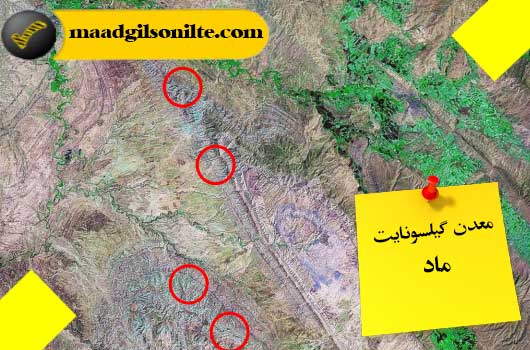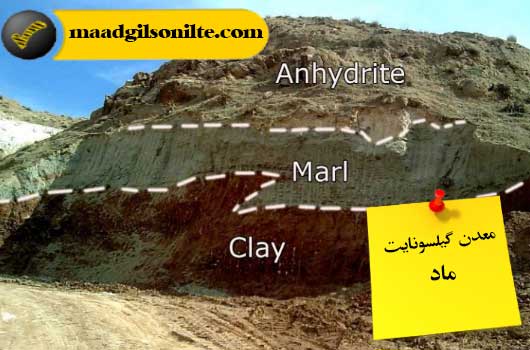
Gilsonite exploration requires knowledge of the geological environment in which this mineral was deposited and the geological processes that led to its formation. Several geological factors are necessary for the formation of gilsonite, such as sedimentary rocks, oil shales, and organic-rich sediments.
Natural bitumen has a unique geology that makes it a distinctive mineral of interest. It is usually found in sedimentary rocks that are made up of layers of sediment. Layers of sediment typically accumulate over millions of years, forming distinct rock formations that can be explored for gilsonite deposits.
In the beginning, it is necessary to know that Gilsonite is a natural and high-quality mineral that is similar to coal and asphalt. It is used for various purposes, including making asphalt, ink, paint and other industrial products. The discovery of Gilsonite is very important due to its increasing demand in various industries. In this article, we discuss the geological formation of Gilsonite, its physical properties and the methods used for its exploration and extraction.
Gilsonite has been used in various industrial applications for over a century. The first recorded use of gilsonite was in the 1860s, where it was used as a natural sealant in water wells and as a waterproofing agent in the construction industry.
Commercial exploration and mining of gilsonite began in the early 1900s when it was found to have excellent binding properties. Since then, demand for Gilsonite has increased and it is now mined and used in various industries around the world.
Gilsonite is formed through the deposition of organic matter in geological basins. Organic matter accumulates over millions of years and is subjected to high pressure and temperature, resulting in the formation of oil.
Over time, oil migrates to shallower depths and closer to the surface. As it moves, it encounters various rock formations and can become stuck in porous rocks, including sandstones and conglomerates.
As the oil undergoes further changes due to heat and pressure, the organic compounds within it polymerize to form gilsonite. The exact process of formation of bitumen is still not fully understood, but it is believed to occur over millions of years.
Gilsonite deposits are commonly found in sedimentary rocks such as sandstone and shale. They can appear in various forms, including streaks, nodules, and layers. The size and shape of Gilsonite deposits can be very different, and the thickness of some of them reaches several meters.
Gilsonite deposits are typically found in areas of high organic matter, such as ancient lake beds, where large amounts of organic matter have accumulated over time. The deposits can be very concentrated, with up to 95% of the rocks being gilsonite.
In most cases, gilsonite is found in association with oil shales, which are sedimentary rocks that contain significant amounts of organic matter. This organic matter eventually turns into oil and gas, and in some cases into gilsonite. This transformation occurs due to a combination of high temperature and pressure over millions of years.

Geological surveys are an essential method for Gilsonite exploration. They include mapping of rock formations, analyzing their composition and evaluating the area’s potential for gilsonite deposits.
Geological investigations can be done through different methods such as aerial photography, ground reconnaissance and geological mapping.
To discover gilsonite, geologists must find areas with the right geological conditions for the mineral to form. They use rock sampling and other exploratory technologies to identify the presence of gilsonite in rock formations.
The presence of oil shales is also a good indicator of the potential presence of gilsonite.
Once a potential deposit is identified, the exploration team will conduct a detailed geological survey to determine the extent and quality of the deposit. This includes mapping rock layers and examining geological structures that may have influenced mineral formation.
Gravity and magnetic surveys are used to measure the Earth’s gravity and magnetic field strength. These surveys can identify underground structures that may indicate the presence of gilsonite deposits.
Gravity surveys measure changes in the Earth’s gravity field caused by the density of rocks below the surface. Measurement of magnetic surveys of changes in the Earth’s magnetic field caused by changes in the magnetic properties of rocks.
Drilling and sampling techniques are used to extract rock samples from the ground for analysis. This can help determine the presence and quality of gilsonite (natural bitumen) deposits.
The most common drilling techniques used in Gilsonite exploration are rotary drilling and diamond core drilling. Rotary drilling involves the use of a drill pipe that rotates to remove rock from the ground. Diamond core drilling is a more precise method that involves using a diamond-encrusted drill bit to extract a cylindrical sample from the earth.
Surface exploration techniques involve collecting data from the Earth’s surface, including measurements of magnetic fields, electromagnetic fields, and gravity. These data points can provide valuable information about subsurface rock formations, including the presence of gilsonite.
Subsurface exploration techniques involve drilling boreholes into the ground to collect rock samples or geophysical data. These techniques are more invasive than surface exploration techniques, but can provide more detailed information about the presence of gilsonite.
Modern exploration methods include the use of advanced technologies such as 3D modeling and artificial intelligence to analyze geological data. These methods can provide a more comprehensive understanding of the geological environment and can help optimize the exploration process.
Seismic surveys involve the use of sound waves to determine the location and extent of Gilsonite deposits below the surface. By analyzing sound waves traveling through the Earth’s surface, geologists can create images of the subsurface and find areas of high concentrations of gilsonite.
Gravitational and magnetic investigations include the measurement of gravity changes and magnetic fields caused by the presence of gilsonite deposits in the subsurface. These changes can be detected using specialized equipment, allowing geologists to pinpoint areas of high gilsonite concentration.
One of the major technical challenges in Gilsonite exploration is identifying subsurface formations without drilling too deep or too shallow. This can be a costly and time-consuming process, and improper drilling can result in no gilsonite deposits being found.
Gilsonite exploration and extraction can cause environmental damage, including habitat loss, air and water pollution, and soil erosion. It is very important that exploration and extraction activities are carried out in a responsible and sustainable manner in order to minimize their impact on the environment.
Gilsonite exploration and mining is subject to numerous governmental and legal regulations. Obtaining the necessary permits and complying with these regulations can be a time-consuming and costly process. In addition, legal challenges from environmental groups or local communities can delay or even stop exploration and extraction activities.
Gilsonite exploration and mining can have significant environmental impacts, especially when it comes to the ecological impacts of mining. In order to extract gilsonite, companies must open mines, remove soil and rock, and disturb the natural landscape. This can lead to habitat fragmentation and soil erosion, which can negatively impact local wildlife populations.
Exploration for gilsonite requires a detailed understanding of the geologic environment in which the mineral forms and the geologic processes that led to its formation. Geologists use rock sampling and other exploration technologies to identify potential deposits, and mining techniques are used to extract this mineral. Proper mine site management is critical to protecting the surrounding environment, and Gilsonite’s unique properties make it ideal for a variety of industrial applications. In general, understanding the geology of gilsonite is essential for its exploration, extraction, and industrial use.
Gilsonite exploration and extraction from the ground requires specialized techniques and brings significant technical, environmental and legal challenges. These include identifying the location of gilsonite deposits, developing effective exploration techniques, reducing environmental damage, and complying with regulations.
For the exploration of Gilsonite, geophysical techniques such as seismic surveys, gravity and magnetic surveys, resistivity surveys and electromagnetic methods are used.
Gilsonite has unique properties that distinguish it from other natural resources such as coal, oil and gas. While not as abundant as coal or oil, it is environmentally friendly and has a lower carbon footprint. Gilsonite has been used as a substitute for coal and oil in some applications.

